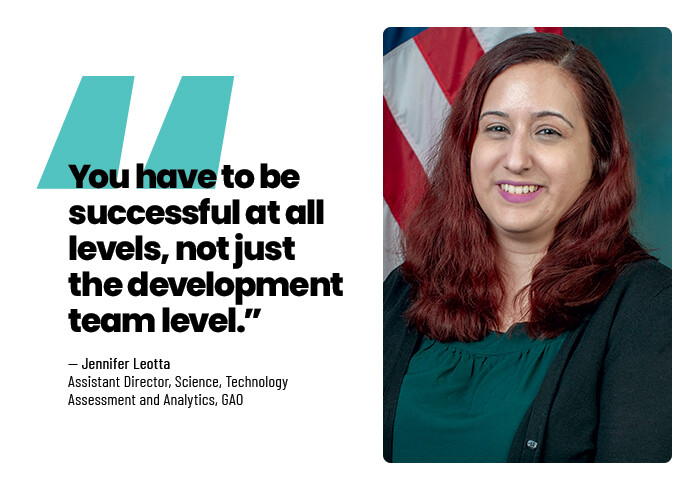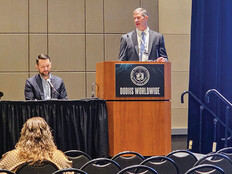Historically, agencies have sometimes struggled to deliver software projects on time and under budget. The traditional waterfall development approach — where all requirements were defined at the beginning of a project, everything was built at once and testing only happened at the end — often produced applications that were buggy and bloated.
“It was all or nothing,” says Brian Bothwell, director of the Science, Technology Assessment and Analytics (STAA) team at the Government Accountability Office. “And a lot of programs ended up with nothing. They spent a lot of money to get a product that didn’t do what they wanted or didn’t work at all.”
But after the passage of the Federal Information Technology Acquisition Reform Act in late 2014, agile development and related approaches such as DevSecOps became increasingly common across the federal government. In the decade since, agencies as diverse as the Centers for Disease Control and Prevention (CDC) and the General Services Administration (GSA) have embraced agile development processes that prioritize rapid delivery, user feedback and continuous improvement.
Embracing and improving agile development is a never-ending process, and IT leaders across government continue to refine their approach and embrace agile adoption best practices. The GAO Agile Assessment Guide sorts these best practices into three overarching categories: team dynamics, program operations and organization environment.
Click the banner below to learn more about continuous app modernization.
According to GAO guide, agile teams should be “self-organizing,” meaning they are empowered to collectively own the software product they’re working on, drive their work forward and decide how their work will be accomplished.
“Agile approaches emphasize psychological safety,” says Mike Griffiths, a consultant with the Project Management Institute. “People talk more now about building empowered teams so that everybody has a say in how the work gets done.”
Soliciting Team Feedback With Human-Centered Design
When the CDC modernized its National Electronic Disease Surveillance System (NEDSS) using agile development, leaders wanted to improve the user experience and boost the ability to analyze and share disease-related health information across state, territorial, local and tribal health departments.
During the modernization effort, CDC worked with CDW team members, who recognized the importance of building trust and buy-in with stakeholders. The project team recommended the adoption of a human-centered design methodology to ensure the concerns of epidemiologists and other stakeholders were heard, addressed and incorporated into the modernization plans.
GSA created a cross-functional team when the agency set out to build Login.gov, a shared authentication platform that allows citizens to log in to dozens of government websites with a single set of credentials. The organization embedded security experts from CDW with development teams from the start.
“You have to be successful at all levels, not just the development team level,” says Jennifer Leotta, assistant director of GAO’s STAA team. “At the organizational level, there should be policies in place that support different responsibilities.”
Ensuring ‘Flexibility of Scope’ Through Program Operations
As defined by GAO, program operations is an expansive topic that comprises staff training in agile methods, a technical environment that enables agile development and program controls that are compatible with agile processes.
“One of the reasons we believe it’s important to have these program controls is that a key tenet of agile is flexibility of scope,” Leotta says. “That’s not necessarily true for all government programs. Program controls that tie the functionality, features and requirements to the cost and schedule are important for government accountability.”
7%
The percentage of agile teams that have achieved full proficiency in “great agile practices”
Source: forrester.com, “Amid The AI Hype, Agile Still Remains Relevant In 2025,” Jan. 23, 2025
Griffiths says tools such as Microsoft Azure DevOps services can help create a technical environment that keeps agile development on track.
“A lot of what we’re manipulating is information and ideas, and those are invisible and intangible,” he says. “It’s not like we’re building a bridge, and we can see its progress. We need to make the invisible and intangible work visible, and there are a lot of tools that can help us do that.”
MORE FROM FEDTECH: FedRAMP 20x will leverage automation like never before.
GSA leaned heavily on AWS infrastructure during its Login.gov build. The development team relied on automatic alerting to keep user data safe and avoid loading engineers down with repetitive work. The team also worked closely with AWS to ensure scalability and enable disaster recovery.
At the CDC, modernizing the NEDSS system meant starting with small, actionable steps, which demonstrated real progress to stakeholders who had previously expressed skepticism that the project would yield results. The development team identified patient search, data entry and nonstandard workflows as areas where the impact could be felt nearly immediately. By standardizing the process for recording patient data, developers made it easier for epidemiologists to find, create and update existing patient information within the system.
An Organizational Culture That Embraces Agile
Industry observers often talk about how agile development has as much to do with culture as it does technology. This is largely what the GAO means by “organization environment,” which is characterized by clearly aligned goals, sponsorship throughout the organization, incentives that encourage agile development and a culture that supports agile development, among other features.
The CDC’s modernization of NEDSS required the organization to address entrenched practices and skepticism from public health departments across the country. While the effort led to a new, cloud-based database, the technology was only one aspect of the project, as the organization also made a concerted effort to build trust with epidemiologists, case investigators, managers and IT staff who were disillusioned by past modernization attempts.
For GSA, success on the Login.gov project meant adapting to a growing list of required features and security measures as more agencies became interested in using the tool.
Eventually, leaders realized they were building a system that would serve more than 30 million potential end users. The development team built a system that allows users to upload a photo of their driver’s license, which is then validated against government records. Once their identities are confirmed, users receive a login code via text message or letter.
UP NEXT: Platform engineering boosts productivity.
Griffiths emphasizes the importance of building a culture where agile is embraced not only by leaders but throughout the organization.
“A lot of agile transformations fail,” he says. “If you can make it better than what you did before, then agile is more likely to persist. But if people dislike it, they’ll find ways to break it. People have to see it as a better alternative. Otherwise, when they’re faced with challenges, they’ll revert to their old ways.”













